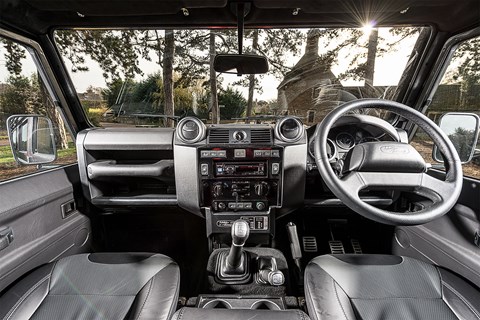► Living with a last-edition Defender
► Ours is an 'Adventure' final edition
► Past its sell-by date, or a nailed-on classic?
Month 6 running a Land Rover Defender: also available as an investment
CJ Hubbard has made my children cry. When I told them he had delivered the news that the Defender was being taken away, it was as though I had said a beloved pet had gone to stay at a farm with great grandma and Squiggles the hamster.
It’s a car that has that sort of effect on a family – as I’ve said before it becomes part of your life in all its infuriating, quirky ways. The kids like it because it’s a climbing frame and playroom all in one. Because ours didn’t come with running boards as it’s a manly Adventure version for manly stuff, they had to heave themselves in by their elbows. We genuinely discussed the possibility of tying ropes to the grab handles to help them get in.
That might have helped my wife too. She loves the Defender because she’s a country type a bit like Audrey Fforbes-Hamilton from To The Manor Born and she would happily volunteer to drive it whenever the occasion occurred. Problem is, she got herself marooned on numerous occasions in the Waitrose car park due to the lamentable turning circle and lack of parking sensors, and when she took it to school one day she flashed half the boys in the sixth form when she was trying to get in to it. She’s a teacher, I should clarify.
And this is the strength of the Defender. It seems to create stories, and funny ones, like all the best things do. We could have done all the things we did and gone all the places we went in the Defender in a Discovery Sport, or a Land Cruiser. But none of those experiences would have involved the character of the Landie, with picnics in the boot, Christmas trees lashed to the roof, bikes, dogs, kids, grandparent rolling around in the back.
What I want out of a car is a sense of personality. If I want a machine for moving about in, I’d buy a Hyundai or Toyota. With a Defender you are buying into tradition, and worth, and these things have to be earned. Since production stopped, prices have soared, and so have thefts. People, good and bad, have recognised the value of the Defender, in monetary and metaphysical terms. The way the car industry now operates and plans, we will not see its like again – the car that transcends mere travel and becomes a part of generations of lives. The Defender is gone, but I suspect it will always be here.
Count the cost
Cost new £43,495 (no options)
Dealer sale price £45,395 (yes, it’s gone up!)
Private sale price £43,445
Part-exchange price £40,195
Cost per mile 20p
Cost per mile including depreciation £1.21
Check out the prices above. The part-ex price is used to calculate depreciation. If it was the dealer price, Defender would be appreciating!
Logbook Land Rover Defender 110 Station Wagon manual
Engine 2198cc 16v, 118bhp @ 3500rpm, 262lb ft @ 2000rpm
Transmission 6-speed manual, four-wheel drive
Stats N/A 0-62mph, 90mph, 295g/km
Price £43,495
As tested £43,495
Miles this month 524
Total miles 3245
Our mpg 23.4
Official mpg 25.5
Fuel costs overall £640.83
Extra costs £0
By Steve Moody
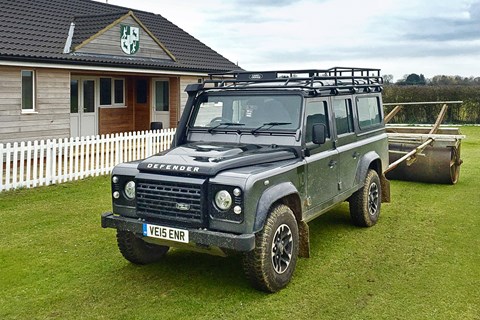
Month 5 running a Land Rover Defender: pressed into action, again
CAR art director Matt Tarrant loves stroking balls through the covers. As a result, we have been employed at the local cricket club rolling the outfield to ensure he gets maximum runs for his glorious drives. You get these jobs thrust on you when you have a Defender.
The Landie towed the venerable one-tonne contraption without raising a sweat, but the Goodyear Wrangler tyres’ sharp-edged blocks left trails of teeth marks in the softer areas of the lawn-like surface. Gives Matt an excuse when he misfields though, I suppose.
By Steve Moody
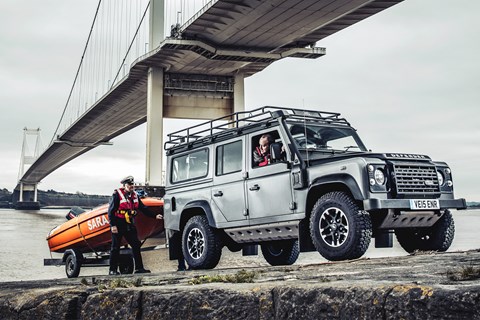
Month 4 running a run-out edition Defender: Being a hero, just for one day
And there it was – a weather forecast which suggested it was going to snow the next day. This made me very excited. I packed the Defender the night before with shovel, tow rope, wellies, balaclava, flares, St Bernard and dried foods in preparation for a day saving the people of Rutland from snowy graves. What a hero my Defender and I would be as we hauled these frozen unfortunates out of ditches, or ploughed through seemingly impenetrable drifts to rescue shivering grannies from ice-bound cottages.
So with the uncontrollable excitement of a kid at Christmas, I leapt out of bed the next morning and threw open the curtains to see what the world had in store for me, and what I could do to help. Sunshine. Mild, gentle breezes. Blue skies. Sometimes I feel I’m driving around, looking like the equivalent of a frogman going to the local swimming baths in full North Sea rig-inspecting clobber. Just my luck to be running a car built to smash through the conditions that test the very limit of human survivability in a winter that is the warmest and wimpiest on record. Perhaps that’s what has actually done for the Defender in the end – not EU crash protection, or emissions, or production line capacity, but a half-baked climate.
But of course, what makes the Defender one of the greatest cars ever built is, like some particularly strident fungus, its ability to adapt and thrive in any environment. It is why it has been the rescue vehicle of choice around the globe for innumerable decades. And despite its end, there is no end, for there are thousands of Landies still out there helping to save lives. Most cars as they get old become gilded relics, rolled out on sunny days and striped lawns for rich people to fight over ownership. Land Rovers just keep getting more battered, just keep saving the world.
Having failed to provide any meaningful rescue services myself, we chugged over to Bristol to see how the experts do it. There are eight Defenders in the Severn Area Rescue Association (SARA), a volunteer lifeboat organisation that not only provides rescue services on one of the most treacherous waterways anywhere in the world, but also on the cliffs, mountains, rivers and lakes that accompany the banks of the Severn. There are two Defenders at their Beachley HQ, sited directly under the formidable structure of the original Severn Bridge, while the others are based at the five stations up and down the estuary, where nearly 200 personnel deal with 300 callouts a year.
It’s a brutal environment where fast thinking and intimate knowledge of the tides and mudflats are essential. Only an estuary in Nova Scotia has a tidal rise greater than the Severn, and when it comes in4 here, it is remorseless. Not only does it fill up in barely two hours, but it comes at the unsuspecting from all directions: racing in from the sea but insidiously up through the sand too, turning solid ground into a porridge that sucks victims into it. Mervyn Fleming, Commander SARA (Area West), wouldn’t run any other vehicles than Defenders to operate in these conditions.
‘We use the Land Rovers as workhorses, because they will carry five people and a small amount of equipment inside, and a fair amount on the roof rack, and can tow a boat, caravan or trailer too,’ he says. ‘They are just so adaptable: we put racking systems in them and they carry a very heavy load, with a winch and a high-velocity pump as well, stakes for driving into the ground and the roof rack for two stretchers, and a mud rescue platform.’

The Landies, one of which is a P reg, ex Western Power vehicle with 138,000 miles on the clock (it might have been round the clock a couple of times, half-jokes Mervyn) and the other, a sprightly new model from 2009, not only tow the boats, but pull victims clean out of the sludge using the winch. A long airbed, blown up with a compressed gas cylinder can be rolled out over the mud, allowing rescuers to get to those stranded.
As the water drains away, I eye up the foreshore for a spot of off-roading. Mervyn is having none of it. The mud looks solid enough, but it is three feet until you hit solid ground, and even the Defender’s off-road ability won’t get it through that. But he’s convinced they are still the best rescue vehicles in the world. ‘The thing is, they just keep going and going. There’s a body of opinion which says Japanese cars are better and somebody offered us one once. We said well, thanks very much, we can use it, but we’ll always need a Land Rover to get it out of trouble.
‘You’ve got to love it, look after it and maintain it. And along the motorway with a boat on the back, everything will overtake you. But it will get you there. And then when you get there, it can go along a towpath, and then it will do a three-point turn on the towpath to get the boat into the water. I’d question some of the more modern cars’ breadth of capability. And of course, it has one of those engines where you can take a bit off, clean it, and put it back on again.’
We help out launching one of the boats during a training exercise, and I do my best not to reverse their prize craft clean off the slipway. There are appreciative murmurs from Mervyn and his team at our slick new Defender and its grabbing tyres, sturdy roofrack, snorkel and underbody protection. I think they’ve already got it lined up for a few jobs and I wonder whether I might be going home on the train at this rate. Like all lifeboat organisations, SARA is a charity that relies on donations, and as you watch that huge body of water rushing past at 12mph, with the thought that these volunteers will rush out into it at a moment’s notice, I can’t help but feel a bit inadequate in our luxuriously appointed Defender. I’m sure Land Rover wouldn’t mind me lending it for a bit, would they?
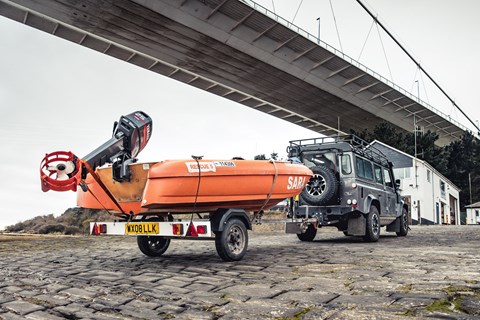
On the way back from Bristol (in Defender, not on South West Trains) I go cross country and due to heavy overnight rain encounter some flooded roads near home. The water rushing off the fields and across the lane was knee deep and some ramblers were turning everyone back. As I approached, they gave me a knowing look. They knew there would be none of that namby pamby nonsense for me.
Our Defender cruised through the sea of muddy water as if it didn’t exist and as I reached dry land, an old lady in a Peugeot 206 wound down her window.‘Do you think I will get through?’ she asked.
I chuckled.‘I’m sorry my dear, but I wouldn’t risk it in that particular vehicle,’ I sagely opined. ‘Best turn round and take the road up over Windmill Hill instead. That should be clear. Safe passage!’
‘Thank you, young man,’ she said. And so, off she trundled, safely heading home to her loving family, not screaming as her little car was swept upstream in a turbulent torrent of murderous water. Just another day in the life of a hero…
From the driving seat
+ Surprisingly stable motorway cruiser
+ Pathetic winter has been no match for it
– ‘Handling’ at any speed is comically bad
– Van engine is noisy and thirsty
By Steve Moody

Month 3 running a run-out edition Defender: seeing the last one built
So, I am running a car that is officially obsolete. Some will argue it has been unofficially so for some time.
I trundled over to Solihull in our Land Rover to see the last one come off the line – number 2,016,933 – and to see the end of an era. Not just the end of an era for the Defender, but for a way of doing things. There are still handmade cars, but none in Britain are made quite like the Land Rover, and never will be again.
As the last cars inched along, it was followed at a reverential, funereal shuffle by the workers who built them, suddenly finding themselves with nothing to do any more. A genuinely sad moment, the cheers from colleagues each time a worker put their tools down for the last ever time as bittersweet as you might witness.
Click here for the full story on the last Land Rover Defenders
Bittersweet sums up the Defender. As a family we love it, with dogs, bikes, kids, constantly to-ing and fro-ing, but being the long wheelbase version on tyres more suited to a Caterpillar quarry truck, it is ludicrously useless at handling and manoeuvring. Parking requires the skills and brawn of a Victorian steam engine driver. If you’re not concentrating you can miss your intended space by five yards. And reversing to rectify the mistake just compounds it.
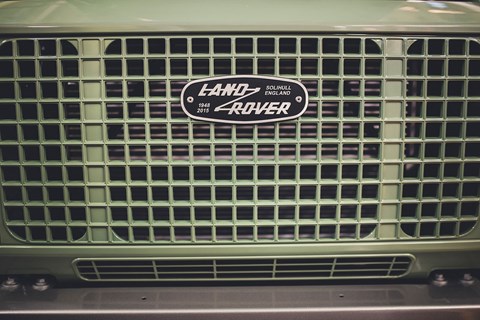
The indicator stalk is an awkward sod that doesn’t work when the car is cold, gears change with a clank not a snick and the steering centres so slowly you must wind your own lock off frantically like you’re trying to stop a weir bursting.
So as I drove out of Solihull, indicators not winking much and doing my usual 17-point exit shenanigans, it was easy to think that this is the end, my friend. Except that in the next month, I’ve got a point-to-point to go to, I need to pull the big roller round the cricket outfield, an adventure to the end of the island needs doing, and a family party means I shall be acting as coach driver for six others, into central London. The Land Rover is dead? Not a bloody chance.
By Steve Moody
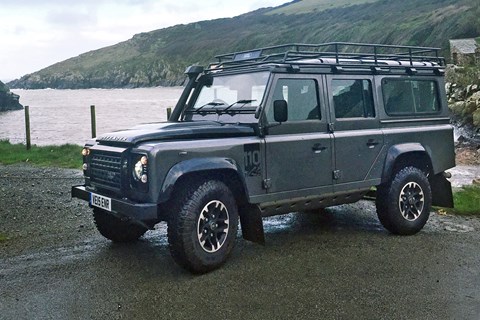
Month 2 running a Land Rover Defender 110: now it’s part of the family
Light body rocked by gales, chunky tyres blasting through flooded roads and torrential rain, fish and chip picnics in the boot: the new year saw us battle 700 miles to Cornwall and back in the Defender, and it proved superbly stoic.
There’s a Buddhist phrase: ‘The Journey is the Reward’, and the anachronistic Defender is part of the story of any trip, very much a member of our family now, integral to adventures, experiences, and my cricked neck from the askew driving position.
Like a dotty aunt, it’s mildly infuriating, yet hugely lovable.
By Steve Moody
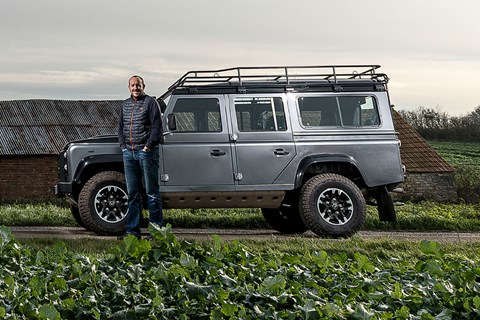
Month 1 running a Land Rover Defender Adventure 110 Station Wagon: the introduction to our long-term test
By the time you read this, the Land Rover Defender will be out of production. Over its life, many other remarkable machines have been invented, built, run, and retired: Concorde, the space shuttle, ZX Spectrum, Metal Mickey. But until now the Defender and its various iterations have continued, many of them in very similar form to the original.
And that’s what makes this car remarkable. Obviously it has been significantly updated, to the point that cynics might say it’s something of a Trigger’s Broom, but I’d contend that conceptually and spiritually the last models off the line, the limited edition models of which our Adventure 110 is one, are true to the simple, focused, rugged concept drawn in Welsh sand in 1947.
So what’s the point of running one for a few months? Surely everything that has ever needed to be said about the Landie has been said? Probably, but what this test is about is trying to explain why this is, in my book anyway, the most significant car ever built by a British firm (angry Mini, E-type, Allegro fans feel free to direct letters to the editor, not me, on this point).
Originally I’d wanted to run the Heritage, attracted as many have been by its 1950 austerity paintjob and steel wheels, but as they’re almost all sold out, we ended up with the Adventure, complete with Goodyear off-road tyres and black alloys, snorkel and underbody protection. In dark Corris grey and black, rather than UN-spec white or Fen-murderer orange, it looks suitably cool and purposeful.
Inside, the Defender has leather seats and a suede roof, and as this will be our family car for the winter months, the luxuries such as heated seats, a radio and um, er, carpets and windows, will come in very useful.
It’s not cheap mind, but then Defenders aren’t these days, whether a hand-built new one or a used example, and ours, which has no options, is £43,495, a figure which makes the people who walk up in the street to talk to me about it, gape in astonishment. And a lot of people do come up to talk to you about it, usually manly men wanting to talk manly stuff about men adventures, until their wives order them off to the shops.
For this is why the Defender still resonates: it reminds us of a time when razors had one blade, men were providers and could do any repairs around the house, and we weren’t this sex of neuroses and self-doubt, emasculated and impractical, unable to put up a shelf or get the car going when it breaks down.
So now all we have left are two symbols of masculinity: our beards, and the Defender. I’m looking forward to a season of hirsute, slow, noisy motoring.
By Steve Moody
As part of CAR magazine's 25 British cars to drive before you die special issue, Ben Oliver drove a 1951 Series I Land Rover back to back with one of the last-of-the-line Heritage editions - click here to read the feature in full on CAR+
